Math 101: College Algebra Ch 1. Foundations of Linear Equations
1/41
There's no tags or description
Looks like no tags are added yet.
Name | Mastery | Learn | Test | Matching | Spaced |
|---|
No study sessions yet.
42 Terms
Consider the numbers 1/2 and 9. Which of the following statements is completely true regarding the most specific classification of these two numbers?
Both of these numbers are whole numbers.
1/2 is a natural number and 9 is a rational number.
1/2 is an irrational number and 9 is an integer.
1/2 is a rational number and 9 is a natural number.
1/2 is a whole number and 9 is an integer.
1/2 is a rational number and 9 is a natural number.
Which of the numbers in the following set are rational numbers?
500, -15, √2, 1/4, 0.5, -2.50, π
500, -15, √2, 1/4, 0.5, -2.50, π
500, -15, 1/4, 0.5, -2.50
500,-15, 0.5, -2.50, π
500 only
500, -15, 1/4, 0.5, -2.50
Which of these statements is FALSE regarding the number 0?
0 is a rational number.
0 is the smallest whole number.
0 is the smallest natural number.
0 is not an irrational number.
0 is a real number.
0 is the smallest natural number.
Which family of numbers begins with the numbers 0, 1, 2, 3, …?
Rational numbers
Natural numbers
Integers
Whole numbers
Real numbers
Whole numbers
What is the special name for the coordinate (0,0)?
Middle
Origin
Original
Center of rotation
Center
Origin
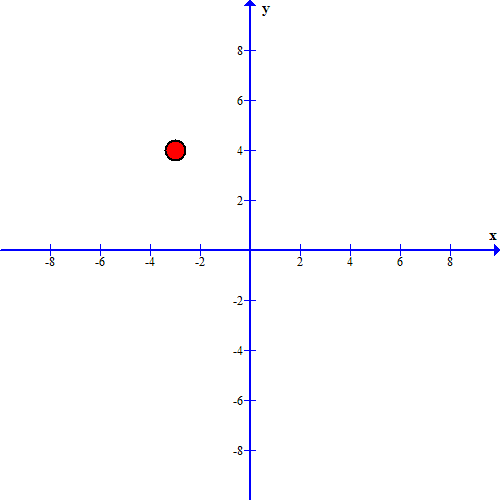
What are the coordinates of this point?
(3, 4)
(-4, 3)
(-3, -4)
(-3, 4)
(4, -3)
(-3, 4)
Which graph has a positive x-intercept and a negative y-intercept?

Which of the following is an example of an ordered pair?
x = 4
y = -3
y = -2x+5
8xy
(2,9)
(2,9)
The point (1, -5) would be found where on the Cartesian plane?
In the upper-right quadrant
In the upper-left quadrant
None of the answers are correct; this equation would not be found on the Cartesian plane.
In the lower-left quadrant
In the lower-right quadrant
In the lower-right quadrant
If the equation y = 50x + 25 represents the amount of (y) money it costs to rent a car for (x) days, how long could you rent a car for if you had 775 dollars?
14 days
15 days
18 days
9 days
15 days
Which graph represents a linear equation?

Which of the following represents a linear equation that begins at 5 and increases by 8 at each step?
y = 8x + 5
y = 5x + 8
5x + y = 8
y = -5x + 8
y = 8x + 5
For which of these line equations is the WRONG slope given?
2x + y = 6; m = -2
y = 0.75x + 2; m = 0.75
3x + y = 15; m = 3
4y = 16x + 18; m = 4
3x + y = 15; m = 3
Which pattern of numbers represents a linear equation?
2, 4, 8, 16, 32, 64
7, 5, 9, 3, 17, 1
3, 9, 15, 21, 27, 33
1, 3, 1, 3, 1, 3
3, 9, 15, 21, 27, 33
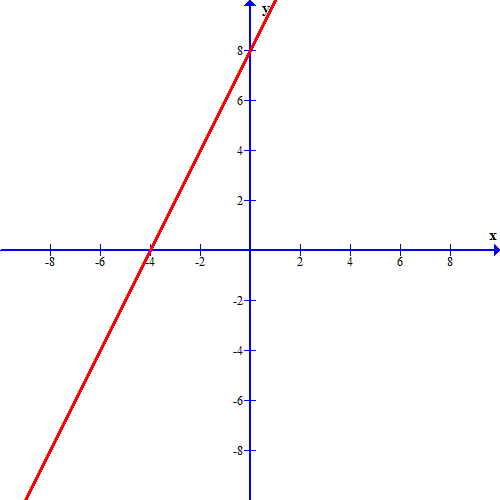
What is the equation of the graph?
-2x + y = 8
2x + y = 8
4x + 8y = 1
-4x + 8y = 1
4x - 8y = 1
-2x + y = 8
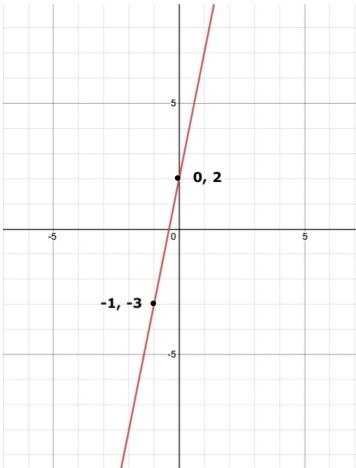
Which linear equation is shown?
y = 4x + 3
y = x/5 +2
y = 5x + 4
y = 5x + 2
y = 5x - 2
y = 5x + 2
Which slope intercept form equation is equivalent to the standard form equation -x + 2y = -8?
y = (1/2)x - 4
y = -2x - 8
y = (-1/2)x - 4
y = -x - 4
y = 2x - 8
y = (1/2)x - 4
Which line has the greatest slope?

If the graph below was written in the slope-intercept form, which of the following would be true?

m = 0, b>0
m>0, b<0
m<0, b<0
m<0, b>0
m>0, b<0
If the graph below has the equation Ax + By = -4, which of these statements is true about A and B?

A = 0, B = 0
A<0, B>0
A>0, B>0
A>0, B<0
A>0, B>0
If the graph below has the equation Ax + By = C, which statement MUST be true?

C = 0
A > 0
B > 0
A < 0
B < 0
C = 0
What is the slope-intercept form equation of the graph below?
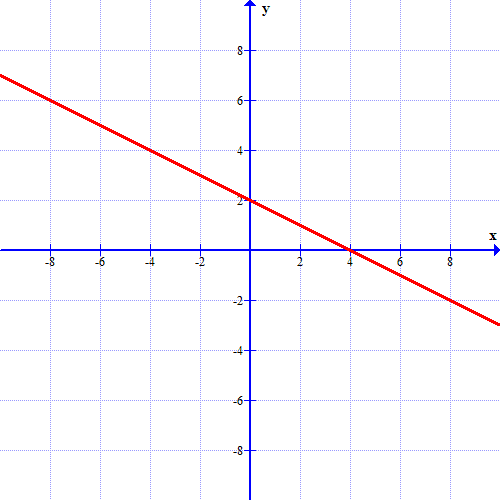

How would you express a line with a zero slope?
y = 0x + b
x = 0y - b
y = 2x - 2b
x = 0y + b
y = 0x + b
For which one of the following lines would the graph fall exactly on top of the x-axis?
y = -2
y = 0
x = 0
y = 2
y = 0
The slope for a horizontal line would be which one of the following?
Undefined
0
1
1/2
0
Which one of the following equations could work for the following graph?

y = 5
y = -5
x = -5
x = 5
y = 5
Which of the following graphs represents x = -3?

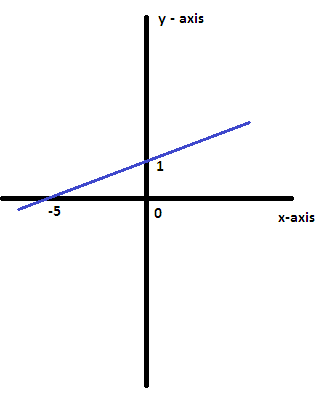
Which of these equations represents a line that is perpendicular to the line in the graph below?

What is the equation of a line that is parallel to y = -4x + 2 and goes through the point (-4, 9)?
y = -4x - 7
y = (1/4)x + 10
y = -4x + 25
y = (1/4)x + 8
y = -4x - 7
What is the slope of a line that is perpendicular to y = 3x + 1?
3
-1/3
1/3
-3
-1/3
Which linear equation has the solutions (2, 4) and (-2, 6)?
y = -2x + 2
y = (-1/2)x + 5
y = 2x + 8
y = (1/2)x + 3
y = (-1/2)x + 5
What is the equation of a line with slope of 2 and a y-intercept of -6?
2x - 6y = 0
y = 2x - 6
y = -6x + 2
y = -2x + 6
y = 2x - 6
Which graph does NOT represent a system of equations?

Consider the following two car rental companies. Cars R Us charges $100 up front, plus 10 cents per mile. Thrifty Car Rentals charges 25 cents per mile with no upfront fee. If TC represent the total cost for the car, and n represents the number of miles, which of the following systems of equations best represents this situation?
TC = 100 + 0.10 / n
TC = 0.25 / n
n = 100 + 0.10 / TC
n = 0.25 / TC
TC = 100 - 0.10n
TC = 0.25 - n
TC = 100 + 0.10n
TC = 0.25n
n = 100 + 0.10TC
n = 0.10 TC
TC = 100 + 0.10n
TC = 0.25n
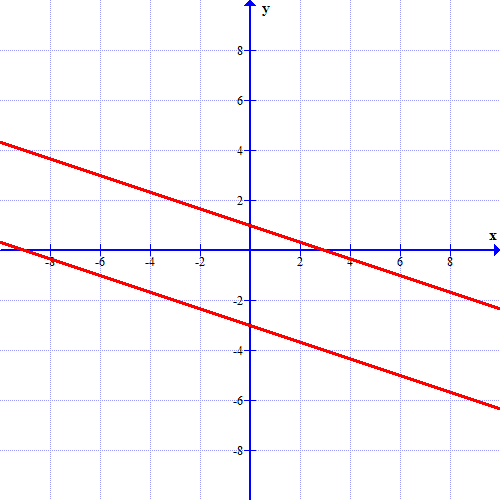
Which of the following is a solution to the system of equations shown in the graph below?
There are an infinite number of solutions.
There is no solution.
(0, 0)
(5, 9)
(1, 1)
There is no solution.
Solve the system of equations below:
y = 3x - 5
y = -2x + 10
(3, 4)
(4, -2)
(2, 1)
(0, -5)
(5, 0)
(3, 4)
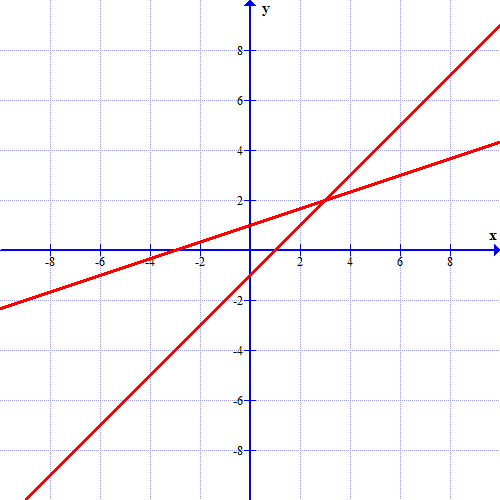
Based on this graph, what is the solution to the system of equations?
(3, 2)
(2, 3)
There are an infinite number of solutions.
There is no solution.
(1, 3)
(3, 2)
When trying to figure out how many $5 burritos and $3 tacos to buy, which equation represents the situation where you have $100 to spend?
100(B +T) = 8
3B = 100 + 5T
5B = 100 + 3T
5B + 3T = 100
5B + 3T = 100
Which of the following represents a valid first step to solving this system of equations using the substitution method?
2x - y = 7
x = 2y - 1
2(2y - 1)- y = 7
x = 2(2x - y) - 1
2x - (2y - 1) = 7
2x - y = 2y - 1
2(2y - 1)- y = 7
A car company has $44,000 to spend on robots to put paint on new cars. There are 2 types of robots, some that cost $3,000 and some that cost $2,000. If the company is sure that it wants to spend all of its money on 16 new robots, how many of each should it purchase?
4 expensive ones, 12 cheap ones
6 expensive ones, 10 cheap ones
10 expensive ones, 6 cheap ones
12 expensive ones, 4 cheap ones
12 expensive ones, 4 cheap ones
Which equation represents a valid first step to solving the following system of equations using the elimination method if our next step is to add the equations together to eliminate the x variable?
2x - 2y = 5 and -4x + 5y = 11
-2(-4x + 5y) = -2(11)
2(-4x + 5y) = 2(11)
2(2x - 2y) = 2(5)
-2(2x - 2y) = -2(5)
2(2x - 2y) = 2(5)
Solve the following system of equations:
2x - 3y = 21 and 5x + 4y = 18
(6,-3)
(-2,7)
(2,2)
(9,-1)
(6,-3)






















